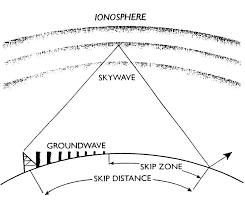Short wave radio . . . – – – . . .
So, HF radio (High Frequency), what’s that all about? Well, we all have heard about amateur radio and Morse code etc. HF radio, was and still is a good way to make contact with people across continents. Let’s forget about the Internet and telephones for a moment. The radio frequency band we are talking about is around the 1.5 to 30 Megacycles. Radiated energy at the rate of a few tens of millions of times a second. I say High Frequency but by today’s standards it is very low. Our terrestrial TV lands onto your goggle box using frequencies in the 800 Megacycle range.
The beauty of this HF range, is that radio signals radiated from an antenna connected to a transmitter, behave in an unusual way. The earth is surrounded by a band of charge particles called the Ionosphere, like a big balloon with the Earth in the middle. This invisible band sits at around 80-400Km above the Earth’s surface. This distance varies depending on time of day, year, how much energy the Sun chucks out and temperature and so on. Now, with higher frequencies such as used in FM radio and TV etc. these signals tend to travel in a straight line from the antenna. Given the curvature of the Earth, you could have a line of sight from the antenna which is about 30 miles, hoping that there are not too many mountains in the way. So, trying to receive the signal further than that, you are a bit stuffed. However, the frequencies in the HF band have a tendency to travel upward and hit this Ionosphere. When they do, some of the energy bounces back to the Earth’s surface and again can get reflected back up to the Ionosphere and so it goes on. How exciting I hear you all cry and I can understand that, really. The interesting bit is that the angle by which these signals are bounced back and forth depends on the frequency of the radio wave. The higher the frequency, the more acute the angle. Now then, go and get your school geometry books, there will be an exam at the end of this article. Imagine a triangle forming points, one from the ground antenna, one from the Ionosphere and one back to the Earth’s surface where you have your receiver. As the angle is dependent on frequency, the position where the signal lands on the Earth’s surface to be received changes. Lets say you are transmitting In Albox on a frequency of 8 Megacycles. Someone in the U.K. Liverpool for example (probably just nicked the radio from a local store), may be able to hear you. Jolly good. Change your frequency to let’s say 6 Megacycles and the U.K. listener in Liverpool goes deaf, but someone in Sweden hears you loud and clear. The other factor is as previously mentioned, the height of the Ionosphere changes with time of day and so on. This therefore, (trigonometry basics!) changes the location where the signal from Albox can be heard. You could get to Iceland let’s say (continent, not the store).
This signal can also get caught within various strata of the Ionosphere and bounced around within it. This is where radio amateurs are able to talk to each other, from France, USA, Japan and so on. I was going to add Birmingham, but who would want to? The good thing is, that you do not need loads of power to achieve this. 100 watts or less of power could get you all over the planet.
Before the days of Internet, satellite communication etc, HF radio was the way to communicate over vast distances. During the War, HF was used to send encrypted Morse code, telemetry and speech, keeping in touch with all concerned. The ‘British Colonies’ relied on radio to keep in touch with the mother land and the BBC World Service had a network of transmitters set up for this reason. Companies around the world such as Marconi had sophisticated mathematical models to work out precise frequencies that could be used in order that, let’s say the West Indies could hear the Queen’s Christmas broadcast, with personnel present to ensure they stood up straight. An interesting example for the use of HF radio was a thing called Weather Fax. The Met Office used to (still do) transmit a facsimile signal containing low speed facsimile picture of weather fronts. Anyone with a radio receiver and Weather fax machine could have a print out of what was happening area by area. This was used heavily by shipping fleets and so on.
Nowadays, HF radio is more used by amateurs who like the buzz of finding intercontinental mates to chat with. Many of these chaps and chapesses, like the challenge of using the smallest amount of power to communicate over vast distances. Spain has a vibrant network of amateurs, such as the EA7 group (easily found on Facebook), headed by the likes of Andy Durrant, local to Albox. More and more utility companies who need to keep an electronic eye on their systems which are spread out over vast distances use this radio service. Sadly, in some ways, Morse code is fading out, being replaced by data communication over this radio spectrum. Think about the Radio Operator on the Titanic who sat at his station as the iceberg took it’s revenge.
However, trust me, with the tensions between our super powers, should our global satellite communications be wiped out, those with H.F. radio stations will be king! All seriousness, as part of the radio amateur agreement, in times of crisis, those operators will be required to provide a communication service. So it’s not all about C.B. radio and fat truck drivers.
Seth, Zeta Services. Working hard, for you.




